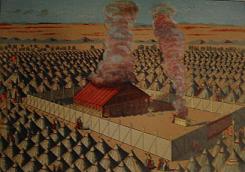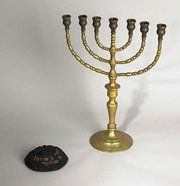Tabernacle
|
|
Template:Dablink The Tabernacle is known in Hebrew as the Mishkan ("Place of [Divine] dwelling"). It was to be a portable central place of worship for the Children of Israel from the time they left ancient Egypt following the Exodus, through the time of the Book of Judges when they were engaged in conquering the land of Canaan, until the time its elements were made part of the final Temple in Jerusalem about the 10th century BC.
The English word "tabernacle" is derived from the Latin word tabernaculum meaning "tent, hut, booth". Tabernaculum itself is a diminutive form of the word taberna, meaning "tavern". The word Sanctuary is also used as its name.
Tabernakel_536x282.jpg
The Tabernacle, reconstruktion
The TabernacleReconstruction
| Contents |
Hebrew mishkan
The Hebrew word, however, points to a different meaning. Mishkan is related to the Hebrew word to "dwell", "rest", or "to live in", referring to the "[In-dwelling] Presence of God", the Shekhina (or Shechina) (based on the same Hebrew root word as Mishkan), that dwelled or rested within this divinely ordained mysterious structure.
The Hebrew word for a "neighbor" is shakhen from the same root as mishkan. The commandments for its construction are taken from the words in the Book of Exodus when God says to Moses: "They shall make me a sanctuary (mishkan), and I will dwell (ve shakhan ti) among them. You must make the tabernacle and all its furnishings following the plan that I am showing you." (Exodus 25:8-9). Thus the idea is that God wants this structure built so that it may be a "dwelling", so to speak, for his presence within the Children of Israel following the Exodus.
It is a crucial component for understanding many of the foundations of Judaism, such as the Shabbat (Jewish Sabbath), the Jewish priesthood who were commanded to serve in it, and the meaning and atonement of the sin of the Golden calf.
Contents
The detailed outlines for the Tabernacle and its leaders are enumerated in the Book of Exodus:
- Chapter 25 [1] (http://bible.ort.org/books/pentd2.asp?ACTION=displaypage&BOOK=2&CHAPTER=25) : Materials needed, the Ark, the table for 12 showbread, the Menorah.
- Chapter 26 [2] (http://bible.ort.org/books/pentd2.asp?ACTION=displaypage&BOOK=2&CHAPTER=26) : The Tabernacle, the beams, partitions.
- Chapter 27 [3] (http://bible.ort.org/books/pentd2.asp?ACTION=displaypage&BOOK=2&CHAPTER=27) : The copper altar, the enclosure, oil.
- Chapter 28 [4] (http://bible.ort.org/books/pentd2.asp?ACTION=displaypage&BOOK=2&CHAPTER=27) : Vestments for the priests, ephod garment, ring settings, the breastplate, robe, head-plate, tunic, turban, sashes, pants.
- Chapter 29 [5] (http://bible.ort.org/books/pentd2.asp?ACTION=displaypage&BOOK=2&CHAPTER=29) : Consecration of priests and altar.
- Chapter 30 [6] (http://bible.ort.org/books/pentd2.asp?ACTION=displaypage&BOOK=2&CHAPTER=30) : Incense altar, washstand, anointing oil, incense.
Builders
In chapter 31 [7] (http://bible.ort.org/books/pentd2.asp?ACTION=displaypage&BOOK=2&CHAPTER=31) the main builder and architects are specified:
- "God spoke to Moses, saying: I have selected Bezalel son of Uri son of Hur, of the tribe of Judah, by name. I have filled him with a divine spirit, with wisdom, understanding and knowledge, and with all types of craftsmanship. He will be able to devise plans as well as work in gold, silver and copper, cut stones to be set, carve wood, and do other work. I have also given him Oholiab son of Achisamakh of the tribe of Dan. I have placed wisdom in the heart of every naturally talented person. They will thus make all that I have ordered, the Communion Tent, the Ark of the Covenant, the ark cover to go on it, all the utensils for the tent, the table and its utensils, the pure menorah and all its utensils, the incense altar, the sacrificial altar and all its utensils, the washstand and its base, the packing cloths, the sacred vestments for Aaron the priest, the vestments that his sons wear to serve, the anointing oil, and the incense for the sanctuary. They will thus do all that I command." (Exodus 31:1-11)
Outlines
The tabernacle of the Israelites during the Exodus was a tent draped with colorful curtains, see diagram: [8] (http://www.daat.ac.il/daat/tanach/mishkan/1.htm). The outside was draped with goats'-hair curtains, and the roof was made from rams' skins, see diagram: [9] (http://www.daat.ac.il/daat/tanach/mishkan/2.htm). It was divided into two areas, see diagram: [10] (http://www.daat.ac.il/daat/tanach/mishkan/3.htm) , separated by a curtain: the outer room, containing the seven-branched candelabrum, and the inner room, also known as the "Holy of Holies" (kodesh hakodashim), and containing the Ark of the covenant (aron habrit), see diagram: [11] (http://www.daat.ac.il/daat/tanach/mishkan/10.htm).
Incorporated into Temple in Jerusalem
When King David conquered Jerusalem and his son King Solomon built the first temple known as Solomon's Temple, all the elements of the tabernacle were incorporated into the newly built permanent temple.
Significance for Sabbath
The concluding instructions for the Tabernacle's construction are stated at the end of the Book of Exodus, chapter 31 [12] (http://bible.ort.org/books/pentd2.asp?ACTION=displaypage&BOOK=2&CHAPTER=31), and in that same chapter, immediately following the words about the Tabernacle, God reminds Moses about the importance of the Jewish Sabbath:
- "God told Moses to speak to the Israelites and say to them: You must still keep my sabbaths. It is a sign between me and you for all generations, to make you realize that I, God, am making you holy. Keep the Sabbath as something sacred to you. Anyone doing work shall be cut off spiritually from his people, and therefore, anyone violating it shall be put to death. Do your work during the six week days, but keep Saturday as a Sabbath of sabbaths, holy to God. Whoever does any work on Saturday shall be put to death. The Israelites shall thus keep the Sabbath, making it a day of rest for all generations, as an eternal covenant. It is a sign between me and the Israelites that during the six weekdays God made heaven and earth, but on Saturday, he ceased working and rested." (Exodus: 31: 12-17). [13] (http://bible.ort.org/books/pentd2.asp?ACTION=displaypage&BOOK=2&CHAPTER=31)
The rabbis of the Mishna derive from this juxtaposition of subject-matter, the fact that the commandment to rest on the Sabbath day, as stated in Genesis 2:1-3 "Heaven and earth, and all their components, were completed. With the seventh day, God finished all the work that He had done. He ceased on the seventh day from all the work that he had been doing. God blessed the seventh day, and he declared it to be holy, for it was on this day that God ceased from all the work that he had been creating to function." [14] (http://bible.ort.org/books/pentd2.asp?ACTION=displaypage&BOOK=1&CHAPTER=2) is not pushed aside by the commandments to construct the Tabernacle. Not only that, but the very definition of what constitutes "work" or "actvity" that must not be done by any Israelite, on pain of death (only when there was a Sanhedrin, and only with acceptable witnesses present), is defined by the 39 categories of activity needed for the construction of the Tabernacle and for its functioning as the center of the sacrifices enumerated in the Book of Leviticus.
Relationship to the Golden Calf
Ark_of_the_Covenant.png
Some rabbis have commented on the proximity of the narrative of the Tabernacle with that of the episode known as the sin of the Golden Calf which begins in the Book of Exodus 32:1-6 [15] (http://bible.ort.org/books/pentd2.asp?ACTION=displaypage&BOOK=2&CHAPTER=32). Maimonides asserts that the Tabernacle and its accoutrements, such as the golden Ark of the Covenant and the golden Menorah were meant as "alternates" to the human weakness and needs for physical idols as seen in the Golden Calf episode. Others scholars, such as Nachmanides disagree and maintain that the Tabernacle's meaning is not tied in with the Golden Calf but instead symbolizes higher mystical lessons that symbolize God's constant closeness to the Children of Israel.
Blueprint for synagogues
Synagogue construction over the last two thousand years has followed the outlines of the original Tabernacle, which was of course also the outline for the temples in Jerusalem until they were destroyed. Every synagogue has at its front an ark, aron, containing the Torah scrolls comparable to the Ark of the Covenant which contained the tablets with Ten Commandments. This is the holiest spot in a synagogue equivalent to the Holy of Holies.
There is also usually a constantly lighted lamp, ner tamid, or a candelabrum lighted during services, near this spot similar to the original Menorah. At the center of the synagogue is a large elevated area, known as the bimah where the Torah is read. This is equivalent to the Tabernacle's altars upon which incense and animal sacrifices were offered. On the main holidays the priests, kohanim, gather at the front of the synagogue to bless the congregation as did their priestly ancestors in the Tabernacle from Aaron onwards.
External links
- The Tabernacle and its contents, in Hebrew, with many diagrams (http://www.daat.ac.il/daat/tanach/mishkan/mishkan.htm)
- Jewish Encyclopedia article (http://www.jewishencyclopedia.com/view.jsp?artid=3&letter=T)


